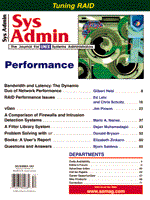
Sidebar : Why RAID at all?
Nearly all vendors of RAID will tout the benefit of improved data availability, but the DBA/SA must remember that RAID in and of itself buys nothing in increased availability unless the vendor's implementation includes component redundancy. Without component redundancy, your RAID implementation will introduce Single Points Of Failure (SPOF) that expose you to more catastrophic failures than you were risking without RAID! Compare the impact of a single drive failure on your operation with the impact of losing all your drives at once (power supply failure). Or consider having your database files (all of them, some of them, who knows?) corrupted by a failing cache. Redundant power supplies and mirrored cache are as important as data redundancy. So are other redundant components. Simplified Storage Management The system administrator's job will be simplified tremendously with RAID. Instead of dozens or more file systems to manage, there will be one or only a handful, and these will be attended with a GUI interface that in itself greatly simplifies things. If you think this aspect of RAID is only a windfall for the admin - not a real system benefit - think again. Complexity spawns error on an exponential curve. Terabytes of storage on JABOD are a daunting management task involving hundreds of drives, dozens of controller cards, yards of cabling and tens of file systems requiring entries into several files. RAID reduces the number of these failure points significantly. Simplified Maintenance The best RAID vendors supply products that are user serviceable. Failed drives can be removed and replaced on the fly. Other components such as fans, power supplies, even controllers can be user serviced, which lowers cost and reduces downtime. This feature is also highly vendor dependent. Most provide a minimal level of user serviceability: drive replacement. However, at least one major vendor completely fails in this regard, actually requiring the customer to purchase expensive support while forbidding the customer to touch the product. Performance Improvements RAID provides performance improvements through efficient load balancing and parallel access. With JABOD, the DBA and SA must constantly monitor I/O and make sure that no one drive gets too much of the load. Database files must be created, data loaded and files allocated in such a way as to increase parallel access. All this requires significant effort in VLDBs and must be redone whenever data access patterns change. With RAID the load is balanced automatically, and there are as many paths to the data as there are drives, so that partitioning of data is less of a concern to the DBA (though the technique can still be used with RAID to good effect).
Now, do you need improved reliability, simplified storage and maintenance, or improved performance? As your database grows in size, the numbers of drives increase and so does the frequency of drive failure. VLDBs are not created for insignificant work, and they are large by definition. Thus, they are generally good candidates for solutions designed to improve reliability. The size of VLDBs will also drive a need for simplified storage. The need for simplified maintenance depends on your uptime requirements and the skill level of your support staff. Performance may or may not be an issue, and depending on the application, RAID may or may not improve it significantly. n
|